 |
| The Independent Traveler's Newsletter PAGE THREE |
 |
| The Independent Traveler's Newsletter PAGE THREE |
SPONSORING THIS ISSUE
Online French Video Immersion Yabla French is an online video magazine for French learnerswho wish to improve their language skills. Authentic French videos include television programs, music videos, interviews, documentaries, and travel. Click on the banner to sign up or learn more! |
|
|
Will the Burgundy 2015
Vintage be the equal of
2005?
by Lynne Hammond, Partner, Bringing Burgundy to You We welcome back Lynne and David Hammond,
an English couple who has lived and run their business in Burgundy
since 2003.
Their first article appeared in the FRANCE On Your Own Summer 2013 issue. Bringing Burgundy to You organizes a private wine tasting Masterclass for groups of 2 to 30 people in Burgundy and elsewhere. They also have an online boutique of Burgundy wines. In this vintage review, Lynne ~ who holds a Diploma from the prestigious École des Vins in Beaune, Burgundy ~ offers opinions on the 2015 Burgundy vintage and looks back over other recent years.
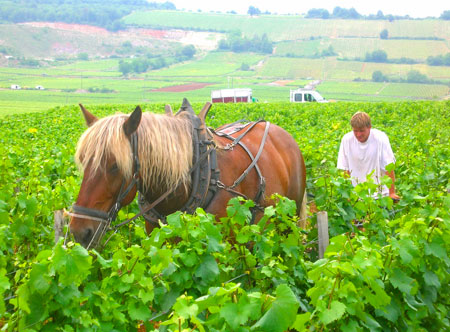 The 2005 vintage is widely considered to be the best for decades. Will 2015 be its equal? Here is what Claude Chevalier, President of the BIVB (Burgundy Wine Trade Body) and Burgundian vintner says: "We have an excellent year that I compare with 2005. This 2015 vintage will, in my mind, enter the annals of history." The 2015 vintage is now maturing in tank and barrel throughout the cellars of Burgundy. Most growers tell us that we are looking at an exceptional year for white and red Burgundy right from Chablis through to Macon. We barrel-tested reds and whites during November 2015, and while some whites were still finishing their fermentation and difficult to taste, others expressed wonderful freshness. The reds had great color and structure and were already reflecting the style of the appellation and, particularly in the case of premier and grand crus, expressed balance between tannins, acidity and fruit. Hot weather but the right type of August rain
Add
to perfect weather the 'human element' of skilled vineyard management
and winemaking, and the result is an excellent wine. After the
2015 harvest, the consensus was that grape quality was superb although
yields, in some appellations, were down again. However, the
shortfall differs markedly across the region with, on balance,
Côte de Nuits suffering more than Côte de Beaune.
Some appellations report up to 30% reduction while others are close to
normal. A living example of Burgundy's remarkable micro-climate,
the Maconnais being further south lacked rain and, consequently, yields
will suffer more while at the northern tip of Burgundy in Chablis a
late hail storm devastated a Grand Cru vineyard with 50-80% losses in
that parcel. Much
of June, all of July and early August 2015 were very hot with
temperatures regularly in the mid to upper 30s. We had drought
conditions and growers in early August were reporting small berries
with little juice. And then, thankfully, it rained! Late
August saw high temperatures but increased rainfall ~ steady rain, not
short, sharp storms. Weather conditions were ideal in the first
ten days of September, the harvest start date for most growers.
Where
has all the wine gone? Although 50% of Burgundy wine is sold within France, the historic UK export market has seen a remarkable drop in quantity from 20 million bottles in 2011 down to 11 million in 2014. The BIVB believes the cause is the rise in price of Chablis and Macon wines (the two most popular in quantity for the UK market) above the symbolic £10 mark. However, overall price increases have averaged out at 5% ~ not a particularly significant figure. Other export markets, notably the USA and Asia, are taking up the slack resulting in an overall small 4% fall in export volumes. Overseas, Burgundy retains its high quality image.
Among recent vintages, 2011 where available, is good to drink now but probably not a wine to lay down. On the contrary, 2012s are excellent to keep and will improve with age ~ although quantities are low. 2013s and 2014s are wines to drink early, as a general rule. So, for those looking to have a cross-section of Burgundy in their cellars, buy a range of 2012s and 2013s and snap up any 2011s, too! But do it now, as the wines are really scarce. Do make sure you leave space in your cellar (and budget!) for the 2015s, which will start to become available toward the end of this year and into 2017. 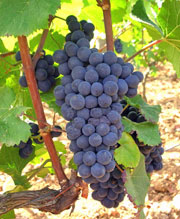 How can Bringing Burgundy to You help? If you are planning to visit Burgundy with a group of friends and family perhaps you will be renting a château or maison. If so, what better way to develop your appreciation of Burgundy wines than a private Burgundy Wine Masterclass. We come to you and take you through a tutored tasting of Burgundy wines while commenting on the geography, terroir, vintners, flavors, aromas and vintages. We also have a web-based boutique of over 100 Burgundy wines and can ship worldwide. Talk with us about our Cellar Plan service where we will advise on the Burgundies you currently have in respect to aging and food pairing, and we can suggest a selection of wines if you are starting to build your Burgundy collection. For information visit www.bringingburgundytoyou.com, email lynne@bringingburgundytoyou.com or call Lynne and David at 33.6.30.42.02.98.
THE BEST TRASH IS TRASH PEOPLE DON'T PRODUCE: Recycling in France
by Arthur Gillette
On at least one
occasion in the late Middle Ages when Paris was under siege, the
municipal
authorities ordered people to bring their trash to the city walls.
There, it
was burned to send up thick smoke and thus discourage the enemy.
So recycling
is not totally new in France! But then it was for military
defense while today
it stems from ecological and economic concerns.
A sign on the door of
a large room in the cellar of my apartment house in the Parisian suburb
of
Meudon (12 train minutes from the Gare Montparnasse) says Salle
des Ordures, i.e., Garbage Room. Inside are several huge
bins, each equipped with two wheels to ease the garbage men's task in
dragging
them to empty into regularly passing trucks. Odd as it may
seem at first sight, flip-up covers of some bins are gray while others
are yellow. The gray ones are for food leftovers and other
garbage
while the yellow ones invite me and my neighbors to recycle household
trash.
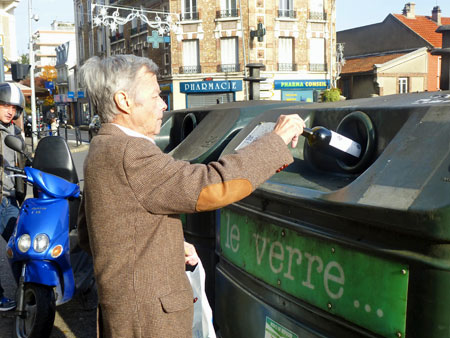 Each year the average home in France produces no less than 600 kilos (1,320 lbs.) of household waste, much of it reusable. In recent years, national-regional-local government authorities, not to forget private enterprises and non-governmental associations, have been paying greatly increased and active attention to proper disposal of this massive mess. Even much of the
apparently useless garbage (gray bin cover – annually worth €430 per
French
household) can be compacted to serve as fuel. As much as
27% of public lighting
in Paris alone is powered by it. And the yellow bin
cover? This must be (but is unfortunately not
always) selectively disposed of to be collected and recycled. It
amounts to some 15,000 tons per year in Paris alone and includes paper,
cardboard, plastic bottles, tin and aluminum cans, etc.
One ton of paper and
paper-based trash recycled saves 1.3 tons of wood from being
'harvested' in forests.
Plastic bottles are mainly, but not only, transformed back into plastic
bottles.
And 19,000 old tin and aluminum cans go into a new car, while 250
of them form a bicycle
frame.
And glass?
Special
bins for recycling bottles and other glass objects have been placed by
local
and regional authorities on sidewalks – fifty-nine in Meudon alone,
i.e., more than
one per thousand inhabitants. Special bins are also available in
public places
for textiles, batteries, light bulbs and so forth.
Recycling
for
transformation
and reuse, including the manufacture of new objects to be sold, has
recently created
more than 18,000 jobs in France. Private enterprise has
been far from inactive in recycling. Much selectively recuperated
and treated
material is recommercialized via various companies, its purchase profit
mainly
helping offset government expenses in this area.
A
national optical store chain (with 1,350
outlets nationwide) has joined other bodies in creating the Krys Group
Enterprise Foundation which not only collects but also cleans and
repairs
eyeglasses which it then provides free of charge to very needy children
and
adults in poor countries. In 2012 alone, this involved
160,000 pairs of glasses
following 12,000 professional voluntarily-executed eye examinations via
25
field projects in Africa, Madagascar and India.
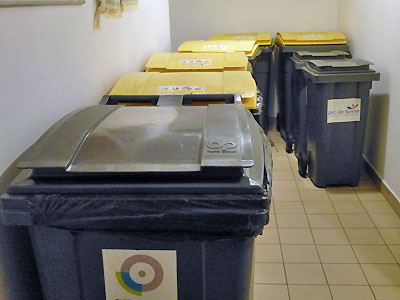 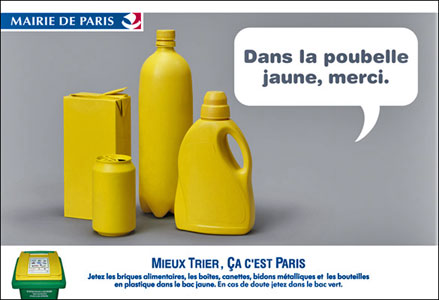
Gray or yellow?
In the yellow trash, thank you.
Put briefly, on a
folder currently going the rounds in Meudon: “The Best Trash is Trash People
Don't Produce.”
[Photos by Madeleine Liegeon unless
otherwise noted.]
|
|
 previous
page
next page
previous
page
next page  |
|